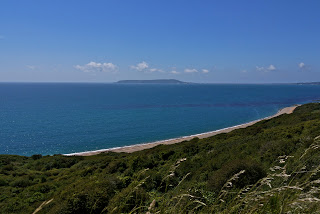Henley Bridge
We had our friend Kathy staying and she expressed a wish to visit Henley, so here we are. As we were heading along the Twford to Wargrave road to Henley I was surprised by the amount of traffic - surely it couldn't be the Henley regatta in the same week as Wimbledon? It was (I thought the "season" was better planned than that) and so we had to park in a field on the Berkshire side of the Thames and walk in from there.
This meant that the first sight of Henley was the bridge of 1786, which really is the ideal place to start. We headed across, ignoring for the moment the regatta on the right and walked ahead into Hart St, with St Mary's church on the right.
Pevsner describes it having a "cheerful Late Gothic exterior". Two churches in nearby Reading have the same checkerboard pattern; I must see if there is any link.
Hart St is a wide street lined with shops and hotels and presents a mainly Georgian character. Just in front of the church is this handsome drinking fountain of 1885.
Pausing to look at it revealed that the churchyard housed a number of almshouses. It seems that they were endowed by John Longland, Bishop of Lincoln, in 1517 (who is also credited with building the church tower), but were rebuilt in 1830 in a Tudor style.
I am very fond of almshouses and although I know Henley reasonably well, I had never noticed these before. It it just further evidence for one of my principles of city walking: approach even places you know as if you were a stranger.
At the end of Hart St stands the Town Hall, with the market place behind. It dates from 1900 and was designed by Henry Hare in the Queen Anne style. A footnote in Pevsner reveals that its 18th century predecessor was moved to nearby Crazies Hill and converted into a house.
We continued further up the hill to reach Friar Park. I did not know of its existence until I did a bit of research to plan this walk. It is a fantastic late Victorian mansion set in a vast park. Pevsner describes it as "a bizarre folly .... a long sprawling building in unfashionable French Flamboyant Gothic style". It was built by a rich solicitor, Sir Frank Crisp, who probably also designed it. You can't see the house, but the gate and gatehouse give a flavour of the style. It looks fabulous.
Of course, nowadays, Friar Park is famous as being George Harrison's house - his widow Olivia and son Dhoni still live there. I knew about the big house near Henley and rows with the neighbours about having razor wire on the perimeter fencing, but I did not know its name and had not realised that the house was actually right in the town. You can see from the map that it accounts for a significant percentage of the area.
We walked back down the hill, past the Town Hall and turned into Bell St and then into New Street. On the right were more almshouses, Barnaby Cottages, originally given by William Barnaby in 1582 and several times restored.
Further along were Anne Boleyn's Cottage and the Tudor Cottage dating from the 15th century. The latter is less fancifully named!
The lower part of the street is dominated by the imposing buildings of the former Henley Brewery.
We turned right into Thameside to follow the river and on this occasion offered great views across to the regatta sight. For some, the sight of the Royal Barge, recently seen in the flotilla down the Thames in honour of the Queen's Jubilee, was a great delight.
On the town side of the street, I enjoyed the decorated gables of the former Little White Hart Hotel (c 1890).
For the final part of our walk, we crossed Hart St into Duke St and wandered down to the riverside to follow the promenade as far as Marsh Lock. All along there were Regatta-goers enjoying drinks and food in moored boats or cruising along the river. We were a bit envious. I was surprised however to see a man in a splendid rowing blazer sitting on a park bench eating fish and chips out of the paper.
The approach to the lock is impressive, with a lovely wooden bridge across the river.
There is also a weir and on the bridge a plaque describes the installation of a salmon ladder. We looked hopefully across the weir pool and - improbable as it sounds - immediately saw a salmon leaping, presumably in search of the ladder. We waited for some time but we did not see another - it seems now like a dream.
We retraced our steps and crossed the bridge for one last view of the regatta, with Remenham Hill behind.
Distance: almost 4 miles.
Conditions: Warm and sunny, though with a threat of rain.
Rating: four stars.
Sightings
Three years ago I saw an exotic duck on the river Blackwater. It turned out to be an Egyptian Goose. The RSPB, who kindly identified it for me, explained that it was probably an escapee. I was surprised to see this group of Egyptian goslings on the Thames, but at least I could confidently say what they were. At this rate they will soon be everywhere.






















































